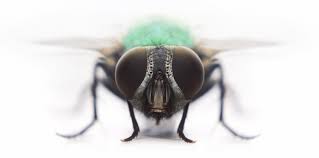Spring. Warmer weather is coming, lovely.
Unfortunately, during this period, fly nuisance is also lurking. Fly nuisance is not only annoying for farmers and their cattle. It also causes stress at cows and the flies transmit diseases. The biggest culprit is the stable fly.
There are many products available to combat flies, such as: use of robber flies, sprays, pour-on, ear flaps, fly catchers, traps, granules, maggot death, etc.
A relatively new way of controlling flies is the above-mentioned use of predatory flies. In recent years, several customers of HappyFarmer tubes with these robber flies were used. And with success.
In this blog we inform you about the operation and use of these robber flies.
Robber flies, mites or wasps?
Robber flies are used in stables with manure pits. Parasitic wasps can be used in stables with straw or other dry types of manure. If there is an explosion of flies (for example at (an early spring with high temperatures, starting too late, etc.) it is advisable to use predatory mites as additional support for the robber flies or parasitic wasps.
Robber fly natural enemy of the stable fly
Stable flies lay their eggs in manure. Furthermore, wet straw, hay and feed residues are also used as breeding grounds. Adult females live for 7-10 days and lay up to 800 eggs during that time. The stable fly population is increasing rapidly because of this.
The robber fly is a natural enemy of the stable fly: the larva of the robber fly feeds on the stable fly larva. This causes the stable fly larva to die and cannot develop into a stable fly.
Laboratory fly
HappyFarmer supplies cardboard tubes containing pupae of the robber fly Ophyra aenescens. This fly is bred in laboratories and is guaranteed not to transmit any germs and therefore poses no risk to the health of livestock. The adult robber fly is smaller than the stable fly. It is easily recognizable by its black color with a metallic shiny body.
The robber flies are not a nuisance to humans or animals, they are light-shy and stay in the manure pit.
Use robber flies
The robber flies are supplied in cardboard tubes containing pupae. After removing the lid, the tubes are hung at places where there is a fly nuisance. After 2-5 days the first adult robber flies emerge from the pupae. They are immediately ready to reproduce: they lay their eggs on the manure.
To build and maintain an effective population of robber flies, it is important to use the cardboard tubes several times a year.
The advice is to use the tubes as follows in the starting year:
- Start in March/April.
- Place the tubes the first 3 times every 14 days.
- Then every 4 weeks.
- In total, the tubes are used 6 times in the first year.
In subsequent years, placing tubes once every 13 weeks is sufficient.
Tips for optimal operation
To optimally use robber flies, the following points are required:
- Remove spilled feed remains at least once a week. The stable fly is then forced to reproduce in the manure.
- Manure that is too dry slows down the development of the robber fly, because it lays its eggs on the border between dry and wet. Moisten the manure regularly. Not too wet; there should always be a thin crust layer.
- Do not mix manure.
- Always leave about ten centimeters of manure in the cellar. If all the manure is removed, almost the entire population of robber flies will be destroyed.
Example costs
A tube robber flies for 75m² stable surface costs at HappyFarmer €24,65.
For a Barn For an area of 825m², eleven tubes are required per treatment.
The costs are per treatment €271,15.
Six treatments are required for the first year. The total cost in the first year is €1.626,90.
In subsequent years, four treatments are recommended (every 13 weeks). The costs are then €1.084,60.
